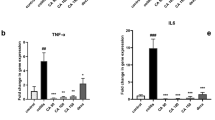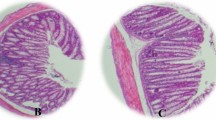Abstract
Background
Ulcerative colitis (UC) is an inflammatory bowel disease with significant morbidity. Cardamonin is a natural chalcone derivative with considerable anti-inflammatory activity. Herein, the potential protective effect of cardamonin against UC was tested in a rat model.
Methods
Rats were given 10 or 30 mg/kg/day of cardamonin orally for 14 days before induction of UC. On the 14th day of treatment, UC was induced by intrarectal instillation of 2 ml 3% acetic acid. Twenty four h after acetic acid instillation, rats were sacrificed and colons were analyzed by macroscopic and histopathological examination. Colon lipid peroxidation was examined by biochemical evaluation of malondialdehyde (MDA). Myeloperoxidase (MPO), iNOS, NF-κB, TNFα levels were measured by ELISA. Moreover, caspase-3 and COX-2 were assessed by immunohistochemical analysis.
Results
Cardamonin at 10 and 30 mg/kg decreased the disease activity index and macroscopic damage index scores, and significantly reduced histopathological deterioration. Additionally, cardamonin reduced levels of MPO, iNOS, NF-κB, TNFα and MDA (p < 0.05). Immunohistochemistry revealed down-regulation of COX-2 and caspase-3 in groups treated with cardamonin.
Conclusion
Cardamonin has a protective effect against acetic acid-induced colitis. This effect may be due to reducing inflammation, oxidative stress and apoptosis.
Similar content being viewed by others
References
Lau MS, Tsai HH. Review of vedolizumab for the treatment of ulcerative colitis. World J Gastrointest Pharmacol Ther 2016;7:107–11.
Baumgart DC, Carding SR. Inflammatory bowel disease: cause and immunobiology. Lancet (London, England) 2007;369:1627–40.
de Dombal FT. Ulcerative colitis. Epidemiology and aetiology, course and prognosis. Br Med J 1971;1:649–50.
Molodecky NA, Soon IS, Rabi DM, Ghali WA, Ferris M, Chernoff G, et al. Increasing incidence and prevalence of the inflammatory bowel diseases with time, based on systematic review. Gastroenterology 2012;142:46–54.
Furfaro F, Bezzio C, Ardizzone S, Massari A, de Franchis R, Maconi G. Overview of biological therapy in ulcerative colitis: current and future directions. J Gastrointestin Liver Dis 2015;24:203–13.
Clark M, Colombel J-F, Feagan BC, Fedorak RN, Hanauer SB, Kamm MA, et al. American gastroenterological association consensus development conference on the use of biologics in the treatment of inflammatory bowel disease, June 21–23, 2006. Gastroenterology 2007;133:312–39.
Seril DN, Liao J, Yang G-Y, Yang CS. Oxidative stress and ulcerative colitis-associated carcinogenesis: studies in humans and animal models. Carcinogenesis 2003;24:353–62.
Singer II, Kawka DW, Scott S, Weidner JR, Mumford RA, Riehl TE, et al. Expression of inducible nitric oxide synthase and nitrotyrosine in colonic epithelium in inflammatory bowel disease. Gastroenterology 1996;111:871–85.
Sklyarov AY, Panasyuk NB, Fomenko IS. Role of nitric oxide-synthase and cyclooxygenase/lipooxygenase systems in development of experimental ulcerative colitis. J Physiol Pharmacol 2011;62:65–73.
Nenci A, Becker C, Wullaert A, Gareus R, van Loo G, Danese S, et al. Epithelial NEMO links innate immunity to chronic intestinal inflammation. Nature 2007;446:557–61.
Frey MR, Edelblum KL, Mullane MT, Liang D, Polk DB. The ErbB4 growth factor receptor is required for colon epithelial cell survival in the presence of TNF. Gastroenterology 2009;136:217–26.
Edelblum KL, Yan F, Yamaoka T, Polk DB. Regulation of apoptosis during homeostasis and disease in the intestinal epithelium. Inflamm Bowel Dis 2006;12:413–24.
Iwamoto M, Koji T, Makiyama K, Kobayashi N, Nakane PK. Apoptosis of crypt epithelial cells in ulcerative colitis. J Pathol 1996;180:152–9.
Zeissig S, Bojarski C, Buergel N, Mankertz J, Zeitz M, Fromm M, et al. Downregulation of epithelial apoptosis and barrier repair in active Crohn’s disease by tumour necrosis factor alpha antibody treatment. Gut 2004;53:1295–302.
Gonçalves LM, Valente IM, Rodrigues JA. An overview on cardamonin. J Med Food 2014; 17:633–40.
Niu P-G, Zhang Y-X, Shi D-H, Liu Y, Chen Y-Y, Deng J. Cardamonin inhibits metastasis of lewis lung carcinoma cells by decreasing mTOR activity. PLoS One 2015;10:e0127778.
Park S, Gwak J, Han SJ, Oh S. Cardamonin suppresses the proliferation of colon cancer cells by promoting β-catenin degradation. Biol Pharm Bull 2013;36:1040–1.
Doug H, Chen SX, Xu HX, Kadota S, Namba T. A new antiplatelet diarylheptanoid from Alpinia blepharocalyx. J Nat Prod 1998;61:142–4.
Wang ZT, Lau CW, Chan FL, Yao X, Chen ZY, He ZD, et al. Vasorelaxant effects of cardamonin and alpinetin from Alpinia henryi K. Schum. J Cardiovasc Pharmacol 2001;37:596–606.
Israf DA, Khaizurin TA, Syahida A, Lajis NH, Khozirah S. Cardamonin inhibits COX and iNOS expression via inhibition of p65NF-kappaB nuclear translocation and Ikappa-B phosphorylation in RAW 264.7 macrophage cells. Mol Immunol 2007;44:673–9.
Kim Y-J, Ko H, Park J-S, Han I-H, Amor EC, Lee JW, et al. Dimethyl cardamonin inhibits lipopolysaccharide-induced inflammatory factors through blocking NF-kappaB p65 activation. Int Immunopharmacol 2010; 10:1127–34.
Ahmad S, Israf DA, Lajis NH, Shaari K, Mohamed H, Wahab AA, et al. Cardamonin, inhibits pro-inflammatory mediators in activated RAW 264.7 cells and whole blood. Eur J Pharmacol 2006;538:188–94.
Hatziieremia S, Gray AI, Ferro VA, Paul A, Plevin R. The effects of cardamonin on lipopolysaccharide-induced inflammatory protein production and MAP kinase and NFkappaB signalling pathways in monocytes/macrophages. Br J Pharmacol 2006;149:188–98.
Dodda D, Chhajed R, Mishra J. Protective effect of quercetin against acetic acid induced inflammatory bowel disease (IBD) like symptoms in rats: possible morphological and biochemical alterations. Pharmacol Rep 2014;66:169–73.
El-Naga RN. Pre-treatment with cardamonin protects against cisplatin-induced nephrotoxicity in rats: impact on NOX-1, inflammation and apoptosis. Toxicol Appl Pharmacol 2014;274:87–95.
Cooper HS, Murthy SN, Shah RS, Sedergran DJ. Clinicopathologic study of dextran sulfate sodium experimental murine colitis. Lab Invest 1993;69:238–49.
Tsune I, Ikejima K, Hirose M, Yoshikawa M, Enomoto N, Takei Y, et al. Dietary glycine prevents chemical-induced experimental colitis in the rat. Gastroenterology 2003;125:775–85.
Bobin-Dubigeon C, Collin X, Grimaud N, Robert JM, Le Baut G, Petit JY. Effects of tumour necrosis factor-alpha synthesis inhibitors on rat trinitrobenzene sulphonic acid-induced chronic colitis. Eur J Pharmacol 2001;431:103–10.
Roelofs JJTH, Rouschop KMA, Leemans JC, Claessen N, de Boer AM, Frederiks WM, et al. Tissue-type plasminogen activator modulates inflammatory responses and renal function in ischemia reperfusion injury. J Am Soc Nephrol 2005;17:131–40.
Bancroft J, Stevens A. Theory and practice of histological techniques. 4th ed. Edinburgh: Churchill Livingstone; 1996.
Buege JA, Aust SD. Microsomal lipid peroxidation. Methods Enzymol 1978;52:302–10.
Randhawa PK, Singh K, Singh N, Jaggi AS. A review on chemical-induced inflammatory bowel disease models in rodents. Korean J Physiol Pharmacol 2014;18:279–88.
Latifi G, Ghannadi A, Minaiyan M. Anti-inflammatory effect of volatile oil and hydroalcoholic extract of Rosa damascena Mill on acetic acid-induced colitis in rats. Res Pharm Sci 2016; 10:514–22.
V P, C G. Protective effect of marine mangrove Rhizophora apiculata on acetic acid induced experimental colitis by regulating anti-oxidant enzymes, inflammatory mediators and nuclear factor-kappa B subunits. Int Immunopharmacol 2014;18:124–34.
Ibrahim RY, Hassan AI, Al-Adham EK. The anti-ulcerative colitis effects of Annona squamosa Linn: leaf aqueous extract in experimental animal model. Int J Clin Exp Med 2015;8:21861–70.
Sakthivel KM, Guruvayoorappan C. Protective effect of Acacia ferruginea against ulcerative colitis via modulating inflammatory mediators, cytokine profile and NF-κB signal transduction pathways. J Environ Pathol Toxicol Oncol 2014;33:83–98.
El-Gowelli HM, Saad EI, Abdel-Galil A-GA, Ibrahim ER. Co-administration of α-lipoic acid and cyclosporine aggravates colon ulceration of acetic acid-induced ulcerative colitis via facilitation of NO/COX-2/miR-210 cascade. Toxicol Appl Pharmacol 2015;288:300–12.
Ren G, Sun A, Deng C, Zhang J, Wu X, Wei X, et al. The anti-inflammatory effect and potential mechanism of cardamonin in DSS-induced colitis. Am J Physiol Gastrointest Liver Physiol 2015;309:G517–527.
Mannasaheb BAA, Kulkarni PV, Sangreskopp MA, Savant C, Mohan A. Protective effect of Agave americana Linn: leaf extract in acetic acid-induced ulcerative colitis in rats. Ayu 2015;36:101–6.
Zheng L, Gao Z-Q, Wang S-X. A chronic ulcerative colitis model in rats. World J Gastroenterol 2000;6:150–2.
Dijkstra G, Moshage H, van Dullemen HM, de Jager-Krikken A, Tiebosch AT, Kleibeuker JH, et al. Expression of nitric oxide synthases and formation of nitrotyrosine and reactive oxygen species in inflammatory bowel disease. J Pathol 1998;186:416–21.
Krieglstein CF, Cerwinka WH, Laroux FS, Salter JW, Russell JM, Schuermann G, et al. Regulation of murine intestinal inflammation by reactive metabolites of oxygen and nitrogen: divergent roles of superoxide and nitric oxide. J Exp Med 2001;194:1207–18.
Yasukawa K, Tokuda H, Tun X, Utsumi H, Yamada K. The detrimental effect of nitric oxide on tissue is associated with inflammatory events in the vascular endothelium and neutrophils in mice with dextran sodium sulfate-induced colitis. Free Radic Res 2012;46:1427–36.
Brennan FM, Maini RN, Feldmann M. Cytokine expression in chronic inflammatory disease. Br Med Bull 1995;51:368–84.
Morris KR, Lutz RD, Choi H-S, Kamitani T, Chmura K, Chan ED. Role of the NF-kappaB signaling pathway and kappaB cis-regulatory elements on the IRF-1 and iNOS promoter regions in mycobacterial lipoarabinomannan induction of nitric oxide. Infect Immun 2003;71:1442–52.
Inoue H, Tanabe T. Transcriptional role of the nuclear factor kappa B site in the induction by lipopolysaccharide and suppression by dexamethasone of cyclooxygenase-2 in U937 cells. Biochem Biophys Res Commun 1998;244:143–8.
Atreya I, Atreya R, Neurath MF. NF-kappaB in inflammatory bowel disease. J Intern Med 2008;263:591–6.
Sedger LM, McDermott MF. TNF and TNF-receptors: from mediators of cell death and inflammation to therapeutic giants — past, present and future. Cytokine Growth Factor Rev 2014;25:453–72.
Lee I-A, Bae E-A, Hyun Y-J, Kim D-H. Dextran sulfate sodium and 2,4,6-trinitrobenzene sulfonic acid induce lipid peroxidation by the proliferation of intestinal gram-negative bacteria in mice. J Inflamm 2010;7:7.
Piechota-Polanczyk A, Fichna J. Review article: the role of oxidative stress in pathogenesis and treatment of inflammatory bowel diseases. Naunyn Schmiedebergs Arch Pharmacol 2014;387:605–20.
Ruemmele FM, Seidman EG, Lentze MJ. Regulation of intestinal epithelial cell apoptosis and the pathogenesis of inflammatory bowel disorders. J Pediatr Gastroenterol Nutr 2002;34:254–60.
Author information
Authors and Affiliations
Corresponding author
Rights and permissions
About this article
Cite this article
Ali, A.A., Abd Al Haleem, E.N., Khaleel, S.AH. et al. Protective effect of cardamonin against acetic acid-induced ulcerative colitis in rats. Pharmacol. Rep 69, 268–275 (2017). https://doi.org/10.1016/j.pharep.2016.11.002
Received:
Revised:
Accepted:
Published:
Issue Date:
DOI: https://doi.org/10.1016/j.pharep.2016.11.002




